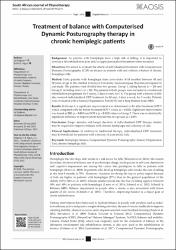| dc.contributor.author | Doğaner, Işıl | |
| dc.contributor.author | Algun, Zeliha Candan | |
| dc.date.accessioned | 2023-10-09T13:43:30Z | |
| dc.date.available | 2023-10-09T13:43:30Z | |
| dc.date.issued | 2023 | en_US |
| dc.identifier.citation | Doğaner, I. ve Algun, Z. C. (2023). Treatment of balance with Computerised Dynamic Posturography therapy in chronic hemiplegic patients. South African Journal of Physiotherapy, 79(1). https://doi.org/10.4102/sajp.v79i1.1918 | en_US |
| dc.identifier.issn | 0379-6175 | |
| dc.identifier.issn | 2410-8219 | |
| dc.identifier.uri | https://doi.org/10.4102/sajp.v79i1.1918 | |
| dc.identifier.uri | https://hdl.handle.net/20.500.12511/11541 | |
| dc.description.abstract | Background: As patients with hemiplegia have a high risk of falling, it is important to develop a fall rehabilitation plan and/or apply personalised treatment when necessary. Objectives: We aimed to evaluate the effects of individualised treatment with Computerised Dynamic Posturography (CDP) on balance in patients with and without a history of chronic hemiplegic falls. Method: Forty patients with hemiplegia (time post-stroke: 8–18 months) between 40 and 70 years of age in the Istanbul Yeniyüzyıl University, Gaziosmanpaşa Hospital participated in our study. The patients were divided into two groups: Group 1, falling history (n = 20) and Group 2, no falling history (n = 20). The patients in both groups were included in a traditional rehabilitation programme for 5 weeks, 5 days a week, for 1 h. The group with a history of falls also received individualised CDP treatment for 20 min, 3 days a week, for 5 weeks. Patients were evaluated with a Sensory Organisation Test (SOT) and a Berg Balance Scale (BBS). Results: In Group 1, a significant improvement was determined in the after-treatment SOT 5 values compared with the before treatment SOT 5 values (p = 0.022). Significant improvement was found in BBS (p = 0.003) and SOT 6 (p = 0.022) values in Group 2. There was no statistically significant difference in improvement between the two groups (p ≥ 0.05). Conclusion: Larger samples and longer duration of individualised CDP therapy studies may be required to improve balance with chronic hemiplegia and a history of falls. Clinical Implications: In addition to traditional therapy, individualised CDP treatment may be beneficial for patients with a history of post-stroke falls. | en_US |
| dc.language.iso | eng | en_US |
| dc.publisher | AOSIS (Pty) Ltd | en_US |
| dc.rights | info:eu-repo/semantics/openAccess | en_US |
| dc.subject | Hemiplegia | en_US |
| dc.subject | Balance | en_US |
| dc.subject | Computerised Dynamic Posturography | en_US |
| dc.subject | Sensory Organisation Test | en_US |
| dc.subject | Chronic Hemiplegic Falls | en_US |
| dc.title | Treatment of balance with Computerised Dynamic Posturography therapy in chronic hemiplegic patients | en_US |
| dc.type | article | en_US |
| dc.relation.ispartof | South African Journal of Physiotherapy | en_US |
| dc.department | İstanbul Medipol Üniversitesi, Sağlık Bilimleri Enstitüsü, Fizyoterapi ve Rehabilitasyon Ana Bilim Dalı | en_US |
| dc.authorid | 0000-0002-9025-026X | en_US |
| dc.authorid | 0000-0002-2476-6567 | en_US |
| dc.identifier.volume | 79 | en_US |
| dc.identifier.issue | 1 | en_US |
| dc.relation.publicationcategory | Makale - Uluslararası Hakemli Dergi - Kurum Öğretim Elemanı | en_US |
| dc.identifier.doi | 10.4102/sajp.v79i1.1918 | en_US |
| dc.institutionauthor | Doğaner, Işıl | |
| dc.institutionauthor | Algun, Zeliha Candan | |
| dc.identifier.wos | 001081673200001 | en_US |
| dc.identifier.scopus | 2-s2.0-85172478638 | en_US |
| dc.identifier.pmid | 37795518 | en_US |
| dc.identifier.scopusquality | Q3 | en_US |


















